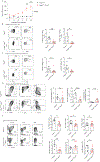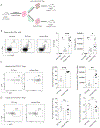Layilin Anchors Regulatory T Cells in Skin
- PMID: 34470859
- PMCID: PMC8489406
- DOI: 10.4049/jimmunol.2000970
Layilin Anchors Regulatory T Cells in Skin
Abstract
Regulatory T cells (Tregs) reside in nonlymphoid tissues where they carry out unique functions. The molecular mechanisms responsible for Treg accumulation and maintenance in these tissues are relatively unknown. Using an unbiased discovery approach, we identified LAYN (layilin), a C-type lectin-like receptor, to be preferentially and highly expressed on a subset of activated Tregs in healthy and diseased human skin. Expression of layilin on Tregs was induced by TCR-mediated activation in the presence of IL-2 or TGF-β. Mice with a conditional deletion of layilin in Tregs had reduced accumulation of these cells in tumors. However, these animals somewhat paradoxically had enhanced immune regulation in the tumor microenvironment, resulting in increased tumor growth. Mechanistically, layilin expression on Tregs had a minimal effect on their activation and suppressive capacity in vitro. However, expression of this molecule resulted in a cumulative anchoring effect on Treg dynamic motility in vivo. Taken together, our results suggest a model whereby layilin facilitates Treg adhesion in skin and, in doing so, limits their suppressive capacity. These findings uncover a unique mechanism whereby reduced Treg motility acts to limit immune regulation in nonlymphoid organs and may help guide strategies to exploit this phenomenon for therapeutic benefit.
Copyright © 2021 by The American Association of Immunologists, Inc.
Figures






References
Publication types
MeSH terms
Substances
Grants and funding
LinkOut - more resources
Full Text Sources
Molecular Biology Databases

